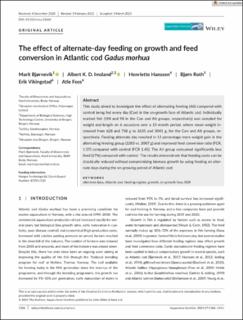| dc.contributor.author | Bjørnevik, Marit | |
| dc.contributor.author | Imsland, Albert K. D. | |
| dc.contributor.author | Hanssen, Henriette | |
| dc.contributor.author | Roth, Bjørn | |
| dc.contributor.author | Vikingstad, Erik | |
| dc.contributor.author | Foss, Atle | |
| dc.date.accessioned | 2021-07-20T10:08:26Z | |
| dc.date.available | 2021-07-20T10:08:26Z | |
| dc.date.created | 2021-07-14T15:06:07Z | |
| dc.date.issued | 2021 | |
| dc.identifier.citation | Aquaculture Nutrition. 2021, 27 1206-1211. | |
| dc.identifier.issn | 1353-5773 | |
| dc.identifier.uri | https://hdl.handle.net/11250/2764806 | |
| dc.description.abstract | This study aimed to investigate the effect of alternating feeding (Alt) compared with control being fed every day (Con) in the on-growth face of Atlantic cod. Individually marked fish (198 and 98 in the Con and Alt groups, respectively) was sampled for weight and length on 6 occasions over a 15-month period, where mean weight increased from 628 and 758 g to 2635 and 3041 g, for the Con and Alt groups, respectively. Feeding alternate day resulted in 13 percentage more weight gain in the alternating feeding group (2283 vs. 2007 g) and improved feed conversion ratio (FCR, 1.07) compared with control (FCR 1.45). The Alt group consumed significantly less feed (27%) compared with control. The results demonstrate that feeding costs can be drastically reduced without compromising biomass growth by using feeding on alternate days during the on-growing period of Atlantic cod. | |
| dc.language.iso | eng | |
| dc.title | The effect of alternate-day feeding on growth and feed conversion in Atlantic cod Gadus morhua | |
| dc.type | Peer reviewed | |
| dc.type | Journal article | |
| dc.description.version | publishedVersion | |
| dc.source.pagenumber | 1206-1211 | |
| dc.source.volume | 27 | |
| dc.source.journal | Aquaculture Nutrition | |
| dc.identifier.doi | 10.1111/anu.13260 | |
| dc.identifier.cristin | 1921747 | |
| dc.relation.project | Norges forskningsråd: 87291 | |
| cristin.ispublished | true | |
| cristin.fulltext | original | |
| cristin.qualitycode | 1 | |
